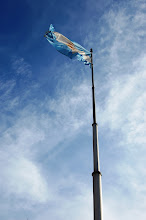Welcome to the final installment of Riding the Colectivo! So far we’ve covered the Guia-T, bus stop behavior, and how to get on the bus without looking like a silly gringo or losing a limb. Yay! The next and final step is getting off the thing once you’ve managed all the above, and it’s really quite easy.
First and foremost, make sure you know the address/intersection you are going to—riding the bus is much less stressful if you know where you are going and don’t have to wing it. I also recommend looking at the route in the Guia-T before setting off so that you know approximately when you should begin the disembarking process. Whenever I’m going somewhere new, I look at the three streets that come before the street I want to get off at, so that I know when mine is coming up. For example, if I’m on the 152 coming down Santa Fe, and I want to get off at Billinghurst, I will look at the three streets before Billinghurst, which happen to be Salguero, Bulnes, and Coronel Diaz. When I see that the bus is passing these streets, I know that I should stand up and approach the door because Billinghurst is coming up.
So, as the bus is barreling down whichever streets its route dictates, pay attention to the names of the streets as you pass them in order to stay oriented. In general, bus stops are located every two blocks, so looking at the “altura” or street numbers can be helpful in determining where you are and when to get off (although they can be hard to see sometimes given the speed at which the buses go whizzing by). When you’ve calculated that your final destination is somewhere within the next three or four blocks, stand up and move towards the nearest door (except the front door, of course).
To signal the colectivero that you would like to get off of his bus, you have to press one of the buzzers (timbres) located on the poles near each door. Sometimes these buzzers actually make a noise that signal the driver, and sometimes they just make a light go off near his seat so he can see that someone would like to bajar. In any case, it’s best to press the timbre firmly and for about 1 second, just to make sure he got the point. However, if you see that someone near you has already pressed the timbre because they too would like to disembark, there is no need to press it again as that would just annoy the driver.
A word of caution: bus drivers here are notoriously violent in terms of their braking capabilities, so hold on tight when he begins the approach to the bus stop. Also, there is no guarantee that the driver will pull up exactly at the bus stop, so OJO when getting off. If there are taxis in the way, or other buses, he might just pull off to the side a little bit and then you have to be careful of oncoming traffic.
So that’s how it’s done! Once you’re on the bus, you can’t really mess it up, because even if you miss your street you can always just get off at the next stop. Unless you fall asleep and end up somewhere in Liniers when you meant to go to Palermo…that would be a big oops.
Anyway, hopefully you’ve learned a bit about the buses here in Buenos Aires and are no longer quite so intimidated by these monsters of transportation. Especially compared to bus systems in the US, the BA bus network really is a wonderful tool and the possibilities are endless once you figure out the basics. Just last night I was in La Paternal aka Pueblo Nowhere for the Manu Chao concert (oh.my.god.amazing) and had to find a way back to Barrio Norte. Out came the Guia-T, and I quickly became acquainted with the 108, 111, and 106, all of which conveniently run between here and there. Perfect!
If anyone has any ideas for more tutorials, just let me know…I’m always up for sharing the things I’ve learned the hard way. And believe me, I’ve learned everything the hard way.
Wednesday, December 2, 2009
Subscribe to:
Post Comments (Atom)


Wow great job explaining the colectivo system, it's so handy if you need to get anywhere that's not covered by the subte, or if you don't live near a subte station. I mostly used colectivos and often forgot about the subte as a transport option.
ReplyDeleteThat was something I never got around to blogging... explaining the Guia T via a blog seemed too hard
thanks! it was definitely a struggle to explain the guia-t clearly...i just tried to think about what i do when i use it! its so handy but if you don't know how it works, its like reading hieroglyphics!
ReplyDelete